#niger-Congo
Text




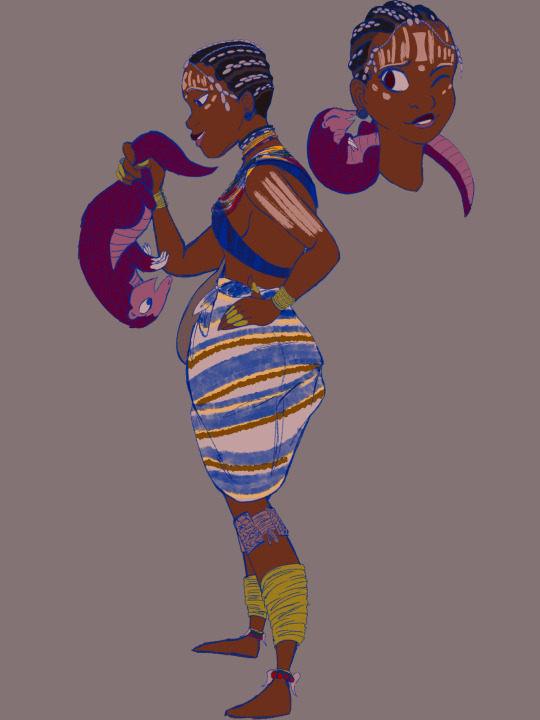
Sketches of beautiful Klao (more commonly known as Kru) girls! It took me forever to find photos that were specifically southeastern Liberian Klao (closer to where my dakwe would be) for accurate reference. I learned about the indigo forehead mark from a Klao journalist’s article so the girls here have it. All the current photos, though, were black and white, so I had to take a guess on some of the colors based on my own real life reference. I really love this and just might make it a series with the Bassa and Vai people, and maybe even the Kpelle. But yeah! I had a lot of fun on this, and I really loved it came out! Just so tumblr doesn’t nuke this post, I did not draw in nipples. It’s stupid but whatever.
Most of their outfits are based off of this photo:
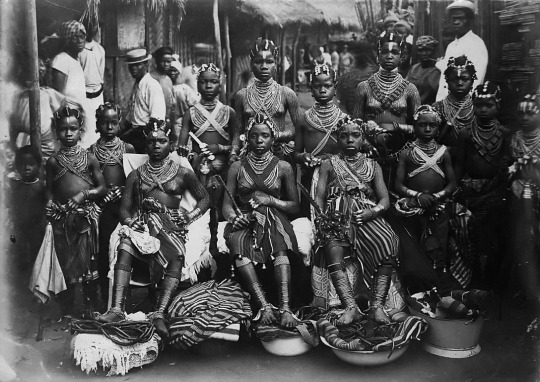
#black artist#African artist#indigenous people#indigenous art#liberia#Klao people#Kru people#niger-Congo#black girl magic#lappa#country cloth#west african#anime girl#black anime#culture#og art#reconnecting indigenous
33 notes
·
View notes
Text
Angélique Kidjo - Agolo (Yoruba)
0 notes
Text



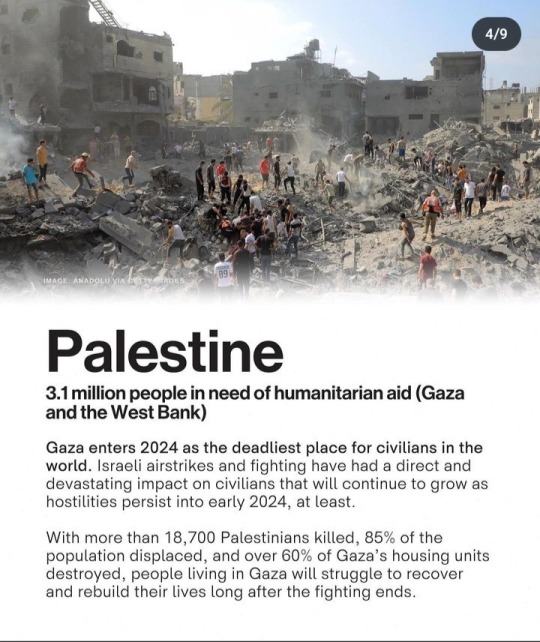



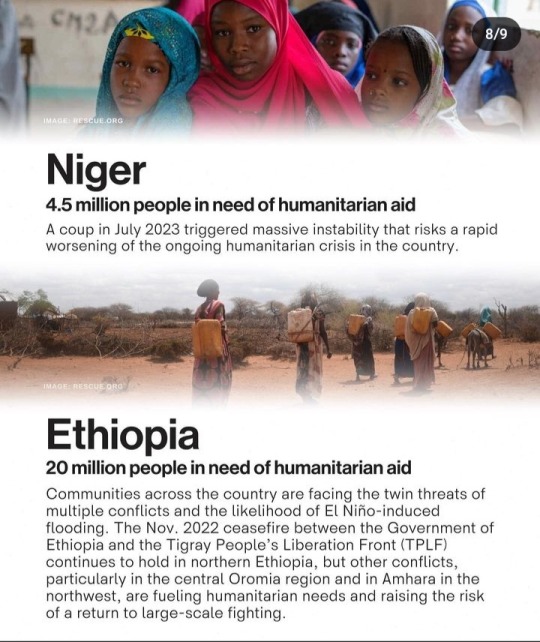
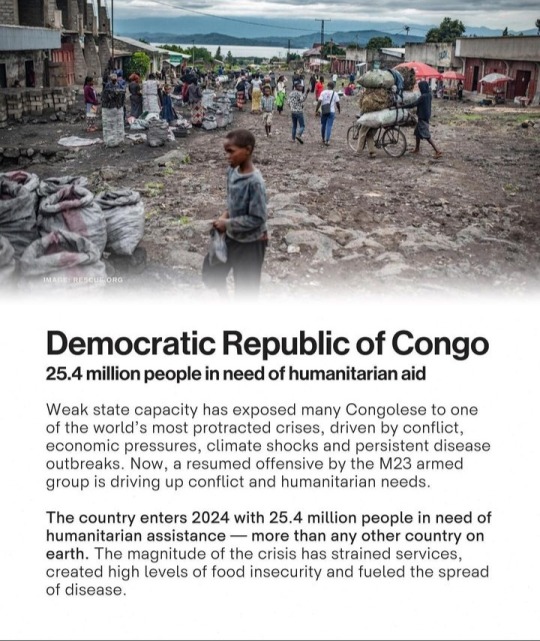
#palestine#free palestine#gaza#free gaza#south sudan#eyes on sudan#keep eyes on sudan#sudan#sudanese genocide#myanmar#eyes on myanmar#talk about sudan#burkina faso#mali#somalia#niger#ethiopia#democratic republic of the congo#congo#congo is bleeding#what's happening in sudan#what's happening in congo#important#current events#eyes on congo#social justice#u.s#israel
692 notes
·
View notes
Text
the 10 crises the world must not look away from:
1. SUDAN
24.8 million people in need of humanitarian aid. a still-escalating war brings sudan to the top of the watchlist. fighting has more than doubled humanitarian needs in less than a year and displaced 6.6 million people- bringing the country to the brink of collapse. more people are internally displaced within sudan than in any other country on earth. in darfur, human rights groups have reported mass killings and forced displacement along ethnic lines.
2. PALESTINE
3.1 million people in need of humanitarian aid (gaza and the west bank). gaza enters 2024 as the deadliest place for civilians in the world. i*****i airstrikes and fighting have had a direct and devastating impact on civilians that will continue to grow as hostilities persist into early 2024, at least. with more than 18,700 palestinians killed, 85% of the population displaced, and over 60% of gaza's housing units destroyed, people living in gaza will struggle to recover and rebuild their lives long after the fighting ends.
3. SOUTH SUDAN
9 million people in need of humanitarian aid. the war across the border in sudan threatens to undermine south sudan's fragile economy and could add to political tensions in the run-up to the country's first-ever elections. meanwhile, an economic crisis and increased flooding have impacted families' ability to put food on the table. a predicted fifth year of flooding could also damage livelihoods and drive displacement.
4. BURKINA FASO
6.3 million people in need of humanitarian aid. as the burkinabè military struggles to contain armed groups, violence is rapidly growing and spreading across the country. roughly 50% of the country is now outside government control.
5. MYANMAR
18.6 million people in need of humanitarian aid. the conflict in myanmar has spread significantly since the military retook political power in 2021. 18.6 million people in myanmar are now in need of humanitarian assistance - nearly 19 times more than before the military takeover. myanmar has seen decades of conflict, but in oct. 2023, three major armed groups resumed clashes with the government. over 335,000 people have been newly displaced since the latest escalation began.
7. MALI
6.2 million people in need of humanitarian aid. dual security and economic crises are driving up civilian harm and humanitarian needs. conflict between the military government and armed groups will likely escalate.
8. SOMALIA
6.9 million people in need of humanitarian aid. somalia faces heightened conflict and climate risks after a record drought. more recently, widespread flooding has displaced more than 700,000 people and will likely continue into early 2024.
9. NIGER
4.5 million people in need of humanitarian aid. a coup in july 2023 triggered massive instability that risks a rapid worsening of the ongoing humanitarian crisis in the country.
10. ETHIOPIA
20 million people in need of humanitarian aid. communities across the country are facing the twin threats of multiple conflicts and the likelihood of el niño-induced flooding. the nov. 2022 ceasefire between the government of ethiopia and the tigray people's liberation front (TPLF) continues to hold in northern ethiopia, but other conflicts, particularly in the central oromia region and in amhara in the northwest, are fueling humanitarian needs and raising the risk of a return to large-scale fighting.
11. DEMOCRATIC REPUBLIC OF CONGO
25.4 million people in need of humanitarian aid. weak state capacity has exposed many congolese to one of the world's most protracted crises, driven by conflict, economic pressures, climate shocks and persistent disease outbreaks. now, a resumed offensive by the M23 armed group is driving up conflict and humanitarian needs. the country enters 2024 with 25.4 million people in need of humanitarian assistance - more than any other country on earth. the magnitude of the crisis has strained services, created high levels of food insecurity and fueled the spread of disease.
— via my.linda__ on instagram
513 notes
·
View notes
Text
Hi! My last donation post reached the 100 link limit so this is my new one. I'm going to work on getting individual lists for each cause and linking them here, so it's a bit more organized than the last one.
I have added a few new links, but for the time being, I am focusing on the campaigns I have listed. While I do not have the capacity to take on anymore campaigns, I will still reblog ones I see others post about to help share them.
I will do my best to keep the links updated with their progress.
DISCLAIMER: I do not vet fundraisers. I do not know enough of the vetting process to do so properly. The few posts I've made where I've spoken with people were just me trying to help show proof they are credible and help them share information. I did this for Wafaa and her family, but I am refraining from doing it for others as it's led to some people thinking I'm a vetter when I'm not and I'm uncomfortable with that. My intention in sharing that post was to help others be able to draw their own conclusions about whether or not to trust the fundraiser. The only other accounts you will see me share information about are ones sent to me by Wafaa or her brother Mohyi because they can vouch for those people.
As for the fundraisers linked on this post, they are all either vetted by others or credible enough to be shared. Majority of the links will take you to the original posts I made when I first shared the fundraiser, where I share how they are vetted or where I got it from. The links for organizations will take you directly to their website or socials.
Palestine
Sudan
Congo
Tigray
Links to more causes:
Hurricane Beryl Relief resources
Arab.org - Daily clicks
World Food Programme trivia game - play to generate donations
‼️ indicates that a fundraiser has experienced a decrease in donations or has been without donations for some time
Stand with Jordan: Transgender Refugee's Battle ($135/$700 - VERY low on funds) ‼️
Help the LGBTQ Refugees of the Kakuma Camp ($194/$1,000) ‼️
The Levin House Child Foundation (gfm: £5,429/£35,000 - VERY low on funds) ‼️
Uyghurs
Support an Uyghur orphan's education (79.10% raised) ‼️
Uyghur Human Rights Project
Static & Noise - Film and Advocacy
Haiti
P4H Global Education Development
P4H Canal Support
Hope for Haiti
Action Against Hunger
List of resources for Haiti made by @/hobiebrownies on twitter (places to donate, accounts to follow, news sources, and educational links)
Thread of gfms for Haiti
Progression Society Art School Fund - A New Start ($3,312 CAD/$5,500 CAD) ‼️
Rohingya Refugees
Donate to help provide education to K-12 students living in the Rohingya refugee camps in Bangladesh. ($5,725/$15,000) ‼️
Stand with Rohingya Families Escaping Genocide in Aceh: The Rohingya Women's Network ($6,130 AUD/$10,000 AUD) ‼️
Qurbani Emergency Aid for Rohingya Refugees ($11,470/$12,000)
Advocating for Peace and Building Hope: RCP Appeal (£12,030/£50,000 - VERY low on funds) ‼️
Nigeria
Donate to the Humanitarian crisis in northwest Nigeria ($2,505 CAD/$15,000 CAD - VERY low on funds) ‼️
Medical and sanitary supplies to support women & children in Congo, Nigeria, and Sudan ($420 CAD/$3,000 CAD - VERY low on funds) ‼️
Claire Aid Foundation
Action Against Hunger
#Palestine#free palestine#Gaza#Rafah#all eyes on rafah#sudan#eyes on sudan#darfur#el fashir#Democratic Republic of the Congo#drc#dr congo#Congo is bleeding#goma#m23 rebels#uyghur#uyghur genocide#uyghur muslims#haiti#free haiti#rohingya#rohingya refugees#myanmar#nigeria#niger delta#pinned post
218 notes
·
View notes
Text
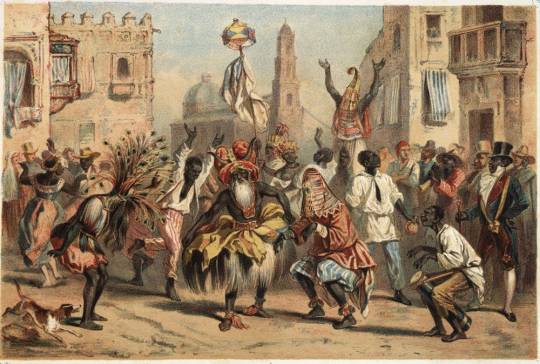
Long before it arose in New York City and became an influential style of music around the world, salsa music has its seeds in African rhythms and traditions that came to the Caribbean through the slave trade. Centuries of enslavement caused many cultural changes in Cuba, including the music that led to salsa.

Some people know Bobby Day’s 1958 “Rockin’ Robin” or Michael Jackson’s remake but the origin of the song goes back to the days of slavery.
The majority of the Africans that were enslaved and brought to the Americas were of West African descent where the drum was used as a form of communication. In the Americas, enslaved Africans used the drum in the same way — communicating with the enslaved on distant plantations and ultimately planning uprising.
The enslavers caught wind of this and enacted a ban.
It is absolutely necessary to the safety of this Province, that all due care be taken to restrain Negroes from using or keeping of drums, which may call together or give sign or notice to one another of their wicked designs and purposes.
— Slave Code of South Carolina, Article 36
That ban went down in 1740 and soon spread throughout Colonial America.
But the beat is in the heart of the African.
We soon found other ways to imitate the sound of the drum; stomping, playing spoons, washboards, or anything other household item. We also “slapped Juba” or played “hambone” where the body became an instrument where the player slaps their thighs and chest for the drum beat. (How did young boys in 1980s Park Hill, Denver know “Hambone?”)
Although we kept the beat, we lost the tradition, a cultural marker snatched away from us.
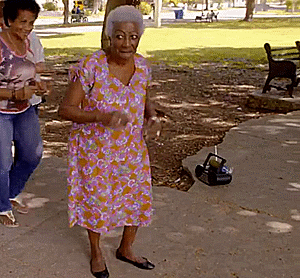
While the American enslaver worked feverishly to destroy any vestige of African culture, the Spanish enslaver of Cuba felt that it was in his best interest to allow the enslaved African to maintain his culture. In support of that, the Spanish allowed the Africans to organize Cabildos (or social groups) based on their nation of origin. Thus you had the Abakua (or Ekpe) from the nations known as Nigeria and Cameroon, the Madinga (or Malinke) from Sierre Leone, etc.
Our focus is primarily on the Lucumi, the Cabildo founded for the Yoruba of Benin and Nigeria. This lineage would be the cornerstone and origin point for what is now called “Salsa.” And what is this “Salsa?”
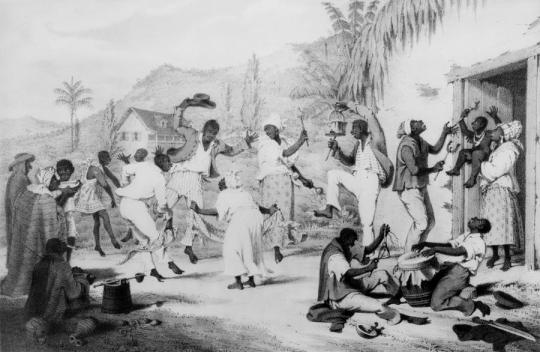
When we spoke of the drum being forbidden among the enslaved Africans in America, we forgot to mention that there was one place that didn’t enact that ban. That place was the port city of New Orleans, Louisiana — some even call New Orleans the Northernmost Caribbean city.
Similar in the way that the Spanish allowed for Cabildos in Cuba, the Louisiana enslavers permitted Sundays off and were okay with the dance and celebration so long as the enslaved African did so outside of the city limits in a place called Place des Negres (eventually known as Congo Square).
After the Civil War, Africans in America were able to get a hold of surplus brass instruments and shortly thereafter began composing music based on the popular music in the Caribbean at the time, the Cuban Habanero. Many say that this is one of the foundations of jazz music itself and the basis of the habanero, the tressilo, can be heard in second lines. Self-proclaimed jazz inventor, Jelly Roll Morton had this to say:
Now take the habanero “La Paloma”, which I transformed in New Orleans style. You leave the left hand just the same. The difference comes in the right hand — in the syncopation, which gives it an entirely different color that really changes the color from red to blue.
Now in one of my earliest tunes, “New Orleans Blues”, you can notice the Spanish tinge. In fact, if you can’t manage to put tinges of Spanish in your tunes, you will never be able to get the right seasoning, I call it, for jazz. Jelly Roll Morton
Because of those qualities, a young musical prodigy from Cuba, Mario Bauzá recognized the similarities between jazz and Cuban music straightaway. Bauzá fell in love with jazz having heard it on Cuban radio but it was his trip to Harlem, NYC in 1927 that convinced him that New York was where he wanted to be and jazz was the music that he wanted to play.
Bauzá returned to New York in 1930, immediately found work, eventually landing a gig in the Cab Calloway band. Here he brought on the legend in the making, Dizzy Gillespie, and the two became fast friends. Bauzá attempted to play his “native” music to many in the band but they dismissed it as “country” music. Gillespie, on the other hand, embraced it.
For the next eight years Bauzá played in predominately African jazz bands having seen discrimination from white Cubans. Yet he longed to start a group that incorporated the music from his home and his second love, jazz. He shot this idea to his childhood friend/brother-in-law and in 1939 at the Park Palace Ballroom the Machito Afro-Cubans would debut.
“I am Black, which means my roots are in Africa. Why should I be ashamed of that?” Bauzá said in reference to the name.
Bauzá replaced the drum kit, which at that time had only been around for 20 years, with the hard to find congas, timbales, and toms. “The timbales play the bell pattern, the congas play the supportive drum part, and the bongos improvise, simulating a lead drum”. In the 40s these drums could only be found at Simon Jou’s bakery, La Moderna, locally known in East Harlem simply as Simon’s.
Next, the Afro-Cubans needed a home and they would find that not in Harlem nor the Bronx, but instead in Midtown Manhattan, a club called the Palladium.

Salsa is a set of Afro-Caribbean rhythms fused with jazz and other styles. The truth is that its origins have always been much debated, although as a general rule it is mentioned that it comes from a fusion that came from Africa in the Caribbean when they heard European music and wanted to mix it with their drums
These origins focus especially on mambo, danzó, cha cha chá, guaracha and son montuno, later enriched with instruments such as saxophone, trumpet or trombone.
It was the Cuban exiles and those from Puerto Rico who popularized salsa in New York back in the 1950s. But it wasn't until the last third of this century that salsa dancing began to take off all over the world.
Cuba played a leading role in the origin of salsa. Already in the 1930s, melodies and rhythms from Africa were playing on the Caribbean island. Among them was the danzón, a musical piece acquired by the French who had fled Haiti.
History tells us that it was these first rhythms that were then mixed with rumbas such as guagancó and sonero to begin to create their own Afro-Cuban rhythms, including Afro-Cuban jazz, mambo, guaracha, Cuban son and montuno.
The exquisite melody of these new rhythms soon set in other Latin American countries. Puerto Rico and Colombia were the first to welcome these new sounds from the Cuban country.
However, it was not until their appearance in the United States, and more specifically in the Bronx neighborhood of New York, when these rhythms acquired a greater impact. It was the moment in which new musical instruments were added that today form an indissoluble part of salsa.
The great Cuban musicians who moved to New York along with the wave of these new rhythms created the famous tumbadoras, congas or son montuno, and were responsible for introducing trombones and guaracha.
The Origin of the Salsa Dance Steps
Once salsa was defined as a musical genre in the 1970s, the movements and steps of its dance were collected through a fusion of the African with the European.
These steps and movements of salsa fundamentally reflect the influence of the dances that the Africans brought to the Caribbean and the European dances that have been danced in Cuba since the 1930s.
So much so that the basic steps of salsa are precisely the same steps as the Cuban son, just as it also includes steps that can be seen in rumba, danzón and mambo.
The origin of these variants is in the regions where this style comes from, which are the ones that developed each dance, always under the same umbrella of the term salsa.
It is not surprising, then, that salsa is defined as the result of a series of social conditions and the evolution of a series of rhythms and melodies from Cuba, which were developed and achieved repercussion in the United States.
There are those who assure against this mixture that salsa is neither a rhythm nor a style, but rather a term that serves to represent all the music of Afro-Cuban origin that emerged in the first decades of the twentieth century.
In short, the origin of salsa has always been, and will continue to be, much discussed. American musician Tito Puente was right when he said, "Salsa doesn't exist. What they now call salsa is what I have played for many years, and this is mambo, guaracha, cha cha chá and guagancó".
#salsa#cuba#congo#nigeria#african#afrakan#kemetic dreams#brownskin#africans#afrakans#brown skin#african culture#afrakan spirituality#nigerian#nigerians#ghana#niger#cameroon#senegal#west africa#afro cuban#american#african american#african american history#american history#dance#african dance#congo dance#ekik#yoruba
20 notes
·
View notes
Text
Firewatch (March 2024 edition, Part 2)
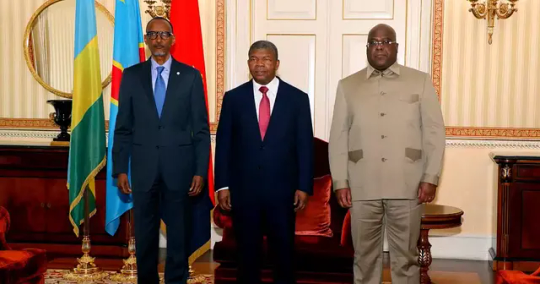
(This is Part 2 of my innagural edition of "Firewatch" becuase I was dumb and didn't realize what the character limit is. Read Part 1 here).
Full piece beneath the cut.
Smoldering Embers
These are the conflicts that, while not yet to the point where the flames are rising and heating up, smoke is starting to billow (or has been billowing) and there's potential for a real blaze to suddenly flare up at a moment's notice. You may have heard about them in the news here and there, but they're likely only popping up for your attention once in a blue moon because they haven't gotten bad or dramatic enough yet to fully grab the world's attention amid everything else going on.
West Africa/Sahel
The Sahel regions of West Africa are no stranger to crisis and conflict. Multiple countries in the region have already been dealing with internal political discord and armed conflict for years, but now multiple factors and various players seem to be converging in this part of Africa, positioning it to take a number of different paths forward in the coming months and years – few of which look very good.
West Africa and the Sahel are feeling a series of different pressures converging all at once. Since 2020, the region has seen a historic number of coup d'etats – both failed attempts and successful ones – which often come with a large amount of public support amid frustration with institutions and leaders that appear to be failing them. One reason for this frustration (among others that should be unsurprising, like economic troubles) is increasing amounts of instability throughout the region. Affiliates of both Al-Qaeda and the Islamic State both have footholds in the region, and are engaged in insurgencies against the governments of Mali (its most recent coup being in 2021, and also fighting a simultaneous insurgency by Tuareg separatists), Burkina Faso (most recent coup in 2022), and Niger (most recent coup in 2023), with Nigeria also dealing with a well over-decade old insurgency against Bokho Haram.
Niger's coup last year, in particular, seems to have been a watershed moment for the region and beyond. The country was strategically important both for its mineral resources (which unsurprisingly have not translated into economic and social development for the people of Niger themselves) and as a geographically well positioned outpost both for France (who's colonial legacy hangs heavily over the region) and the Untied States and other foreign powers, who all had troops stationed in the country to conduct counter-terrorism operations. The coup was seen as serious enough that the Economic Community of West African States (ECOWAS) issued an ultimatum to the Nigerien junta this past summer, threatening that if it did not cede power back to the elected President that ECOWAS would intervene to restore the legitimately elected government (as it has in the past).
Ultimately, the ECOWAS threats have not come to fruition and don't seem likely to – despite some apparent moves to do so in the aftermath of the coup. But out of those threats, Niger has joined into a new political and military alliance called the Alliance of Sahel States with both Burkina Faso and Mali (all of which had been suspended from ECOWAS due to their respective coups) to provide for collective self-defense against foreign intervention. Since 2023, French troops have been forced out of both Burkina Faso and Niger – with Niger now seemingly on the verge of doing the same to the remaining US troops in the country, while Vladimir Putin's Russia has seemingly been on a charm offensive to befriend the members of new alliance signing economic and military agreements and even reportedly dispatching troops – with mercenaries such as those from Wagner already having been active in the area (now operating under the new name of the "Africa Corps").
All these factors and more combined suggest that things in the Sahel are liable to get very interesting in the near future. As stated before, a number of different paths seem to unfold ahead for the region: if the ongoing radical insurgencies continue and are victorious, we could see a new territorial caliphate in West Africa and the Sahel mirroring that of IS in Iraq and Syria in the 2010s (and all the horrors that came with it). Barring that, as Russia deepens its ties to the AES, it could further turn the region into even more of a battleground in the multilateral Cold War we find ourselves in (as Russia is not the only authoritarian power seeking to deepen its influence in West Africa, as Turkey under Recep Tayyip Erdogan is also attempting to get involved there). Those are only two potential options out of many, and the myriad of other options in a region that is heavily populated and on the radar of multiple great powers means that it bears continued monitoring going forward.
The Democratic Republic of the Congo/Rwanda
Now this is one that I imagine is probably flying under the radars of most people who aren't deeper into my field, but is probably one of the most immediately pressing in Africa. The Democratic Republic of the Congo has been fighting against a rebellion by the armed group known as "M23" in its East for a decade now – that much isn't new. But now the conflict is threatening to turn onto a state-on-state war in Africa's Great Lakes region, as M23's primary back of neighboring Rwanda seemingly steps up its direct involvement into the conflict.
Rwanda has been backing M23 for some time now, with both Rwanda's government (under long-time President Paul Kagame) and M23 itself being primarily led by members of the Tutsi ethnic group. Rwanda also has a history of armed interventions in the DRC as well, so that in itself is not new. But in recent months the long-running tensions and low-level conflict between the DRC and Rwanda has threatened to boil over into outright, full-scale war, amid a series of fresh escalations – one prominent example being Rwanda firing on a DRC fighter-jet that it claimed violated its airspace. The high level of tensions has been further evidenced by more direct US involvement recently than is typically seen in this part of the world, with the United States and other governments attempting to broker some kind of peaceful resolution between the DRC and Rwanda. These efforts do not seem to have made much headway, with this past month the United States resorting to publicly urging both the DRC and Rwanda to "walk back from the brink of war." US mediation efforts may well be undermined, however, by it's (and many other Western countries') cozy relationship with Rwanda – despite its autocratic leader.
The trajectory for the current crisis remains unclear. A sideline meeting during the African Union summit in the Ethiopian capital of Addis Ababa appeared to make some progress in at least getting both the DRC and Rwanda to sit at one table and discuss a return to a peaceful dialogue to resolve their differences. However, that same day, the DRC accused Rwanda of having launched a drone attack in the city of Goma – a key objective of M23's advances, seemingly pouring cold war on the idea of constructive and peaceful reconciliation for the time being. Most recently, the DRC appears to be acquiring drones of its own, with China reportedly set to supply the DRC with nine CH-4 armed drones (apropos of nothing, China has also supplied a fair amount of military hardware to Rwanda in recent years, as well as military training).
With little other news available on the crisis since February (with other global events taking precedence), it remains unclear where things with the DRC and Rwanda go from here. There have been reports that the DRC and Rwandan leaders may be preparing to meet face-to-face once more, through mediation by Angola. At the same time, little seems to have changed with the personalities at play. DRC President Felix Tshisekedi was recently re-elected (under conditions labeled a "farce" by the DRC opposition), and has previously taken a hard line on the crisis, threatening to "march on Kigali" if re-elected and the issues with Rwanda persist. The DRC's acquisition of drones from China seems to reinforce that it has no plans of backing down in its confrontation with M23 and Rwanda, even if Tshisekedi doesn't follow through on his more bellicose threats. Meanwhile in Rwanda, Kagame announced his intent to seek a fourth term as President – amid criticism for lifting term limits in order to stay in office longer (criticisms that he has made clear he cares very little for if at all), and so has an impetus to maintain his own hard-line on issues with the DRC.
A further ticking clock has been added to the DRC-Rwanda situation by the fact that the United Nations mission in the Congo – which has been assisting the DRC fight against rebels (including M23) for almost two decades – will now be leaving the DRC by the end of 2024 at the request of the DRC government, stating that the force had not been able to resolve the war with M23. This comes after the DRC government also ordered troops from the East African Community (EAC) that had been present in the country as well to leave in late 2023 – for the same reasons it ordered the UN force to leave. While the DRC may well be right that neither force has helped it to beat M23, the withdrawal of these troops may very well shift the entire balance of the conflict and not necessarily in a way that the DRC wants. The South African Development Community (SADC), led by South Africa itself, is seeking to fill the gap left by the UN and EAC, but it remains to be seen how quickly they can do so and if they can change facts on the ground any more than the UN or EAC could. Once again, we see a number of potential factors on a collision course, and while cooler heads may still prevail, we see the prospect of yet another major war in the heart of Africa's Great Lakes regions that could have significant impacts for the people of the region, the continent, and the world. It is definitely worth keeping an eye on this developing situation (to the extent you can even find news on it).
Ethiopia
Ethiopia, like Myanmar, is a country that has shown up in the past when I've done a round-up on pertinent conflicts in the world. However, unlike with Myanmar, I'm afraid I can't report that things are getting better in Ethiopia's case or that there's much cause for hope at this point. In fact, things seem to be getting actively worse.
The last time I substantively talked about Ethiopia, the government of Prime Minister Abiy Ahmed was engaged in a war in the Tigray region against the Tigray People's Liberation Force – even allying with his former long-time adversary of Eritrea to do so in a war that threatened to rip the country apart while engaging in brutal authoritarian actions that I'm sure are making the Nobel Committee really regret giving him that prize in retrospect. After a seesawing of the fortunes of war back and forth for both sides, the conflict was seemingly brought to a close by the signing of a peace agreement between the TPLF and the Ethiopian federal government. All's well that ends well, done and dusted, right?
Well, actually: no.
Just less than a year after the Tigray War ended, Abiy apparently tripped over his dick into a new internal conflict in mid 2023, this time with Amhara people and forces in the eponymous Amhara region (Ethiopia's second most populous) rather than Tigray. The spark for this conflict was apparently born out of the haphazard way in which Abiy ended the previous one. One of Abiy's key allies in the Tigray War were militias and security forces from the region of Amhara, including an influential armed group known as the "Fano." However, the peace deal that Abiy struck with Tigray did not sit well with many Amahara people, who felt betrayed by the deal due to Tigray claims on their territory (as well as the fact that the Ethiopian federal military and security forces had been unable to prevent the TPLF from occupying Amahara territory during the war). This rift was only made worse by crackdowns by Abiy's government against the Fano, coupled with a plan to absorb Ethiopia's regional security forces into Ethiopia's federal military and security forces, which was not received well among the Amhara. These tensions and more came to a head from April through August 2023, with the result being Abiy's government facing down a fresh and ongoing revolt that doesn't appear to be ending soon.
The result of this bridge burning by Abiy has been a growing war in Amhara occurring under the umbrella of an ever prolonged state of emergency in Amhara that gives Ethiopian authorities broad powers to carry out arrests, impose curfews, and ban public gatherings. This is a continuation of the Abiy's playbook of gross human rights violations from the previous war in Tigray, with accusations being leveled against his government of arbitrary arrests, extrajudicial executions, and indiscriminate killings – including indiscriminate drone strikes against targets such as schools and public transit stations (apropos of nothing, once more, Abiy has acquired his fleet of armed drones from Iran, Turkey, and China – as well as purchasing new fighter jets from Russia). If you're wondering why you haven't heard more about all this, its because Abiy has made heavy handed use of another favorite tactic of his from the previous war (and that it has even used against Amhara in the past), which is information and specifically internet blackouts, which make it very difficult to get information out of Amahara as the conflict drags on (as it did in Tigray during that war).
Abiy's uncanny knack for burning bridges and making enemies isn't limited to within his own country, but has made tensions rise throughout East Africa. At the start of 2024, Abiy signed an agreement with the breakaway region of Somaliland in Somalia, which reportedly gives Ethiopia a naval port on Somaliland's coastline in exchange for recognizing the region's independence from Somalia (something that no other UN member state does). All of this appears to be part of Abiy's quest to regain Ethiopian access to the sea (lost after Eritrea became independent), which has included efforts to re-establish the Ethiopian Navy. The reaction to this deal has been, unsurprisingly, poorly received in Somalia, with Somali President Hassan Sheikh Mohamud even threatening the possibility of war if Ethiopia follows through with it and accusing Ethiopia of outright trying to annex part of Somalia. Somalis are not the only ones unease about Ethiopia's quest for access to the Red Sea, with other East African states such as Djibouti, Eritrea, and Kenya all having previously voiced concern about Ethiopian actions.
There's also the matter of Ethiopia's previously mentioned issues with Egypt over the Nile River, in particular Ethiopia's construction of a massive hydroelectric dam known as the Grand Ethiopian Renaissance Dam (or "GERD") on the river that Egypt worries could have a devastating effect on its water supply downstream if Ethiopia acts without considering Egyptian concerns. Despite numerous efforts to come to an agreement over the dam and the river, every attempt thus far has ended in failure, with Egypt continuing to refer to GERD an "existential threat." Egypt has also made it clear that it stands squarely with Somalia regarding the sea access debacle, with Egypt's autocratic President Abdel Fattah el-Sisi asserting that "Egypt will not allow anyone to threaten Somalia or affect its security," creating a fresh avenue for tension between Egypt and Ethiopia in addition to the GERD issue. This is all in addition to concerns that both Egypt and Ethiopia could be drawn into the aforementioned civil war in Sudan, with numerous potential negative consequences for all involved.
The long and short of things when it comes to Ethiopia, is you have no shortage of opportunities for more intense conflict in the near future, both within and around the country. Abiy's continued heavy handed approach to both domestic and foreign politics creates an ever increasing possibility that one day he will bite off more than he can chew, and potentially spark a conflict of such scale and scope that it could engulf all of East Africa in a major war and potentially even destroy Ethiopia – the second most populous country in Africa – as a polity. Given the potential consequences, this is a part of the world meriting very close observation going forward.
"Do You Smell Something Burning?"
In this final section, I want to touch briefly (as I've already gone on for a few thousand words) on some hot spots in the world that are cause for concern and have been for a while, but have nothing major going on at this moment in time. While they may be quiet (at least relatively speaking, compared to everything else we've just talked about), they have the potential to spark up in the mid to long term and become a problem once again.
The Korean Peninsula
By this point, we're probably all used to North Korea (under its dictator, Kim Jong-Un) shooting off missiles and making bellicose statements. That's par for the course for them. But in recent months, Kim and his government's rhetoric have taken a new and more hostile turn. North Korea has stated it has abandoned the idea of peaceful unification with the South, instead naming it North Korea's "principal enemy" which it will "annihilate" if it is provoked. This comes as North Korea continues weapons tests and conducts multiple military drills – with Kim often in attendance.
While I wouldn't worry about a continuation of the (yet unresolved) Korean War just yet, this may well be cause for concern. While tensions are typical on the Peninsula, we haven't seen rhetoric like this from the North in quite some time. And while full-scale war may be unlikely at this moment (though not impossible), 010 showed us that under the right conditions, the Peninsula is never far from violent skirmishes and incidents between the two Koreas, such as the shelling of Yeonpyeong Island and sinking of the South Korean Navy corvette Cheonan. While wider conflict was avoiding in those cases, now that South Korea has a more reactionary President wanting to present a hard line towards the North, it raises questions about it may react to provocation. Again, while I wouldn't be panicking just yet, it may be worth keeping your ear to the ground on this one to keep from being caught unawares if tensions suddenly spike further.
Armenia and Azerbaijan
Well, they finally did it. I've also written about this conflict several times now, and it looks like by all accounts, Azerbaijan has gotten exactly what it said it wanted. After the world stood by and did largely nothing in its 2020 war against the ethnic-Armenian enclave of Artsakh (AKA: Nagorno-Karabakh), Azerbaijan decided to finish the job once and for all with a fresh offensive on the heels of a nine-month blockade this past year. With next to no prospect of outside assistance, and weakened by the blockade, the Artsakh forces quickly folded, and almost the entirety of the ethnic Armenia population promptly fled in the ensuing days and weeks to avoid violence at the hand of Azeri forces, leaving Azerbaijan free to complete its cultural genocide of the region. But now that its over, surely Armenia and Azerbaijan can find a way to live in peace with this new reality? Right?
Ha ha, no.
In what should be surprising to absolutely no one, Azerbaijan has celebrated getting what it wanted in Artsakh by shifting the goal post once more. Now its new demand is a land corridor connecting it to its ethnic exclave of Naxcivan on the opposite side of Armenia – referred to as the "Zangezur Corridor" (after the Azeri name for the Armenian Syunik province that it would pass through). Armenia seems highly unlikely to agree to such a demand, which it views as an unacceptable infringement on its sovereignty, which likely means – as has been the case after every war fought between these two countries in the past – a new war is almost certainly on the horizon as Azerbaijan will not stop until an outside force compels it to stop and will use the Armenian rejection as an excuse for fresh conflict. 2024 has already seen fresh skirmishes on the border between the two countries, showing that the tensions remain very much present.
It's not clear when this new war will occur, but we can only hope that in the interim more nations step up to actually assist Armenia. We have seen hopeful signs of greater support from other countries, with France and India selling arms to the country to help it defend itself. However, I can't take any of that for granted, with how the world has left Armenia out to dry time and time again. If Azerbaijan does decide to go to war for a land corridor, it also risks potentially sparking a wider regional war, as Iran has called such an action to cut off its land border with Armenia a "red line" (though whether or not it would really take military action in response remains unclear). Anyway, keep your ears to the ground on this one, because like with the other wars Azerbaijan has launched it'll likely come out of the blue.
I'm Very Tired.
I've just thrown a lot of information at you, so I'm going to try and keep this conclusion short and sweet (for me). First, I'll lay out a few takeaways about the wider world situation, and then some general closing thoughts.
Looking at the general state of things with the conflicts I've laid out, I'm going to infer a few things about the general state of global security. For one, Africa is in a dire state in multiple regards and seems to be the biggest place to watch for trouble on the horizon at the moment, as it has several crises that seem ready to boil over into major wars in the near future – if they haven't already in some cases. These crises and conflicts have the potential to pit some of the most populous countries on the continent against one another, and also to rip some of those same countries apart internally. Short of that, Africa is also seemingly getting teed up to be the sight of a new round of intense great power competition for influence and resources the likes of which we haven't seen since the Cold War, with said competition not just involving big players like the United States, Russia, or China, but attracting newcomers to the influence game too – as the UAE's involvement in Sudan's civil war has shown. Finally, it's also worth noting that now that we're in a post-Russian invasion of Ukraine world where large scale state-on-state conflict is back on the menu after many "experts" thinking it was dead and gone, it makes some of the fault lines we're watching here even more important to keep a close eye on.
There's almost certainly more that I say here, but these are just some big overarching themes to take away from this round of observation. Now, for the closing thoughts:
I know you're tired. We all are. I am.
That being said, we can't give up in our fight for a better world for everyone living in it. That requires remaining well informed (to the extent that you're able) about what's going on in that world. This is especially true if your government is playing a role in it (for good or for bad), or it isn't and it should be. Information is, in its own right, power.
I know that your emotional energy is precious, and likely being eaten up but a number of different things at any given moment. I'm not ask you to drop everything and devote all your time and energy to these causes or others, nor am I trying to shame you for not paying as close attention to them as I or others have. Simply, to add them to the Rolodex of your brain as something that matters and that you should check in on once in a while so you're not caught unawares when new developments occur that may affect you and others.
There's only so much that all of us can do about any one issue, either at home or abroad. But we do what we can, and in order to do that, we need to have an idea of what's going on. So take that as you will after reading all this (or anything else that I write or post, for that matter).
On that note, I'll let you get back to whatever else you need to do. But thank you for taking the time to read this and potentially learn more about events you may not have known much about and their potential impacts. I'll hopefully see you again for my next essay, but in the meantime: stay safe out there and don't give up.
Photo credit: africanews/AFP.
#War Takes#War Takes essay#War Takes Firewatch#West Africa#Sahel#Niger#Burkina Faso#Mali#Democratic Republic of the Congo#Rwanda#Ethiopia#Armenia#Azerbaijan#South Korea#North Korea#war#international relations#foreign policy#defense#security
21 notes
·
View notes
Text

Kitty's watching the sunbeams on the ground again.
Lion (Panthera leo)
Parts of Africa as well as Gujurat, India
Status: Vulnerable (global); Critically Endangered (West African population); Endangered (Indian population)
---
At the time of the ancient Greeks, lions roamed most of Africa and from Greece to India. They are now limited mostly to conservation areas in Africa and the Gir National Park in India.
Today's lion and yesterday's tortoise relate to a tarot/oracle reading I saw the other day on Youtube, so... call this a little bit of manifestation if possible. Bring me some lion's power. 🔥
One thing that suddenly struck me was this. I've looked at a lot of tarot decks because I love art and symbolism. I realized that while SO many Strength cards feature the classic lion, it's strange that I think I've never seen one—even in feminine decks—that features a lioness. The maned lion is of course iconic and lovely in art, but the lioness can be such a feminine power symbol.
So I thought I'd draw this lovely lady.
#lion#feline#big cat#mammal#lion art#artists on tumblr#tarot#strength#lioness#africa#asia#india#benin#botswana#burkina faso#cameroon#central african republic#chad#democratic republic of the congo#ethiopia#kenya#mozambique#nigeria#niger#namibia#senegal#somalia#south africa#south sudan#sudan
15 notes
·
View notes
Text
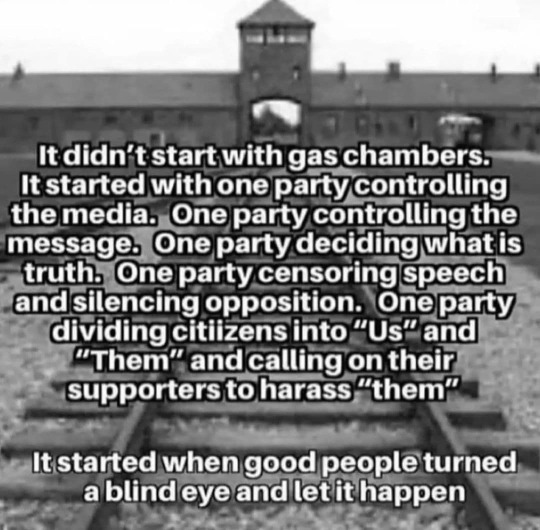
History repeats itself again and again !!!
#what's going on#ethnic cleansing#genocide#who cares#stop the genocide#crime against humanity#palestine#sudan#congo#niger republic#uighur#rohingya#yemen#syria#afghanistan#lybia#native americans#what's the common denominator#american government#usa government#medias#lobbies#selling weapons is a business#they get rich selling arms and killing innocent civilians#they want to control the world#with their lies and propaganda#zionism is the new nazism
14 notes
·
View notes
Text

#language#langblr#lingustics#english#(I’m sorry if the examples are a bit eurocentric but I tried to get some fun non-european ones in there!)#I love the ones (like Tamil) that are live long/live for a hundred years#and most of these have really cool follow ups for if you sneeze for a second time#(especially french and turkish!! go check them out!!)#At least three languages from the hypothetical Niger-Congo lamguage family simply has ‘sorry’ as the reply#which is also really cute#this is such a dumb little language topic (/pos)#but it’s so fascinating!!#I always get sorta put off when I’m reading/watching something and ‘bless you’ is the response to a sneeze#I guess I’m just so used to ‘prosit’#maria talks about things
2 notes
·
View notes
Text
> What is YorubaName.com?
YorubaName.com is an online intervention to preserve and document all Yorùbá names in a multimedia format. It is part of a long-term project to document all types of African cultural experiences on the internet as a way of ensuring the survival of African identities in their various expressions.
Initially presented as a university thesis in 2005, this multimedia dictionary of Yorùbá names found a new iteration in January 2015 as a crowdsourced platform run by volunteer language enthusiasts from around the world. It is supported by funds from hundreds of individual donors who contributed to an Indiegogo fundraising campaign that ran from January to March 2015. This website was launched in February 2016.
7 notes
·
View notes
Text
speaking of bad songs i think the only 'pop christmas' song i actually despise is that 'feeeeed the woooooooorld' song.
#'where nothing ever grows.... no rain nor rivers flow...'#nile niger congo orange zambezi and several several others
2 notes
·
View notes
Text
Le plus grand orateur au monde est le pétrole africain !

Thème : Intérêts français et influence russe au Ghana
Thomo : Le plus grand orateur au monde est le pétrole africain ; Liberté, Égalité, Fraternité.
Brant écrit, à partir de quelques questions «L'attaque lâche et la mort tragique de Darya Dugina ont suscité partout des commentaires et des évaluations sur la pensée «dughinienne» et sur les effets politiques que l'attaque brutale pourrait avoir. Une attitude récurrente de la part des correspondants étrangers des journaux européens à Moscou (je cite El Pais mais ce n'est pas le seul cas) est celle d'attribuer le titre de "fasciste" à Alexandre Douguine. » dans la presse, que probablement l'expression radical appartient aussi à l'ordre des grandes unités signifiantes, qui correspondent à des sens globaux, répandus, latents, qui n'appartiennent pas à la même catégorie que les sens isolés et discontinus du langage articulé du Le radical démocrate Aleanz. Ou les passages de détroits tels que Bab el-Mandeb, Ormuz et Malacca, papiers décisifs de la fragilité de nos économies et de nos approvisionnements, toujours exposés à une pluie de risques structurels (il suffit de penser au blocus du canal de Suez) et d'averses géopolitiques dicté par l'énorme trafic de navires, la piraterie et les troubles politiques. Mais cette opposition entre une micro-sémantique et une macro-sémantique pourrait peut-être constituer une autre façon de considérer l'Afrique comme un radical républicain, abandonnant le plan du cimeterre… pour passer au plan de l'AFR africaine, c'est-à-dire à celui de la significations, répandues, dans toutes les voies marxistes de l'ANC. Mais il conviendrait, à ce stade, de s'inspirer des modèles rhétoriques (et non plus littéralement des Républicains français) isolés de la politique actuelle et de la visite française en Afrique, la République française, Emmanuel Macron, ajoutant que désormais la France être « un interlocuteur neutre » des pays africains. Depuis Libreville, capitale du Gabon et première étape d'une tournée (1-5 mars) qui comprend également l'Angola, le Congo et la République du Congo, le locataire de l'Elysée a annoncé le début d'une nouvelle politique africaine pour la France, … Il faut donc arriver à une véritable définition du désir qui montre, en même temps, la « faim et la vérité africaine est une priorité pour nous » dont la conscience est comme excavée dans le processus d'appétit de la contestation républicaine radicale. .AFR.
#Morocco#Mozambique#Namibia#Niger#Nigeria#Republic of the Congo#Réunion#Rwanda#Saint Helena#São Tomé#Senegal#Seychelles#Sierra Leone#Somalia#South Africa#Sudan#Eswatini#france#uk#china#Uganda#Western Sahara#lgbtq#Botswana#Angola#Cameroon
8 notes
·
View notes
Text
youtube
#Ukraine#Russia#Putin#Zelensky#Drones#NorthKorea#India#Japan#SouthAfrica#DRC#Congo#France#Niger#Youtube
2 notes
·
View notes
Text
The mind-boggling complexities of Africa's 1,500 languages were clarified by Stanford University's great linguist Joseph Greenberg, who recognized that all those languages fall into just five families (see Figure 19.2 for their distribution). Readers accustomed to thinking of linguistics as dull and technical may be surprised to learn what fascinating contributions Figure 19.2 makes to our understanding of African history. (...) Concealed at the top of Figure 19.2 is our first surprise, a big shock for Eurocentric believers in the superiority of so-called Western civilization.
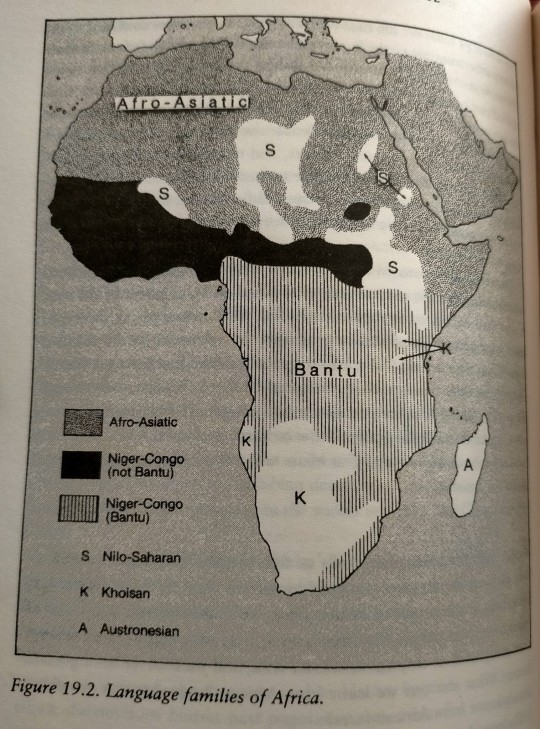
The next surprise in Figure 19.2 is a seeming detail on which I didn't comment when I just told you that distinct peoples tend to have distinct languages. (...) The fragmented distribution of Nilo-Saharan languages in Figure 19.2 similarly implies that many speakers of those languages have been engulfed by speakers of Afroasiatic or Niger-Congo languages. (...) If you look again at Figure 19.2, you'll see that the Niger-Congo language family is distributed all over West Africa and most of subequatorial Africa, apparently giving no clue as to where within that enormous range the family originated.
"Guns, Germs and Steel: A Short History of Everybody for the Last 13,000 Years" - Jared Diamond
#book quotes#guns germs and steel#jared diamond#nonfiction#language#stanford university#joseph greenberg#linguistics#african history#bantu#niger congo#afroasiatic#african languages
3 notes
·
View notes
Text
youtube
New Holland Dabang 85HP Tractor For Sale in UAE - Book Now in Dubai, Sharjah, Abu Dhabi, Ajman, RAK
#Nigeria#Kenya#Ghana#SouthAfrica#Egypt#Uganda#Tanzania#Zambia#Ethiopia#Botswana#Senegal#Mozambique#Angola#Malawi#Rwanda#Burundi#Namibia#SierraLeone#Liberia#Zimbabwe#Mauritius#Swaziland#Lesotho#CentralAfricanRepublic#Gabon#Congo#Togo#Benin#Chad#Niger
0 notes